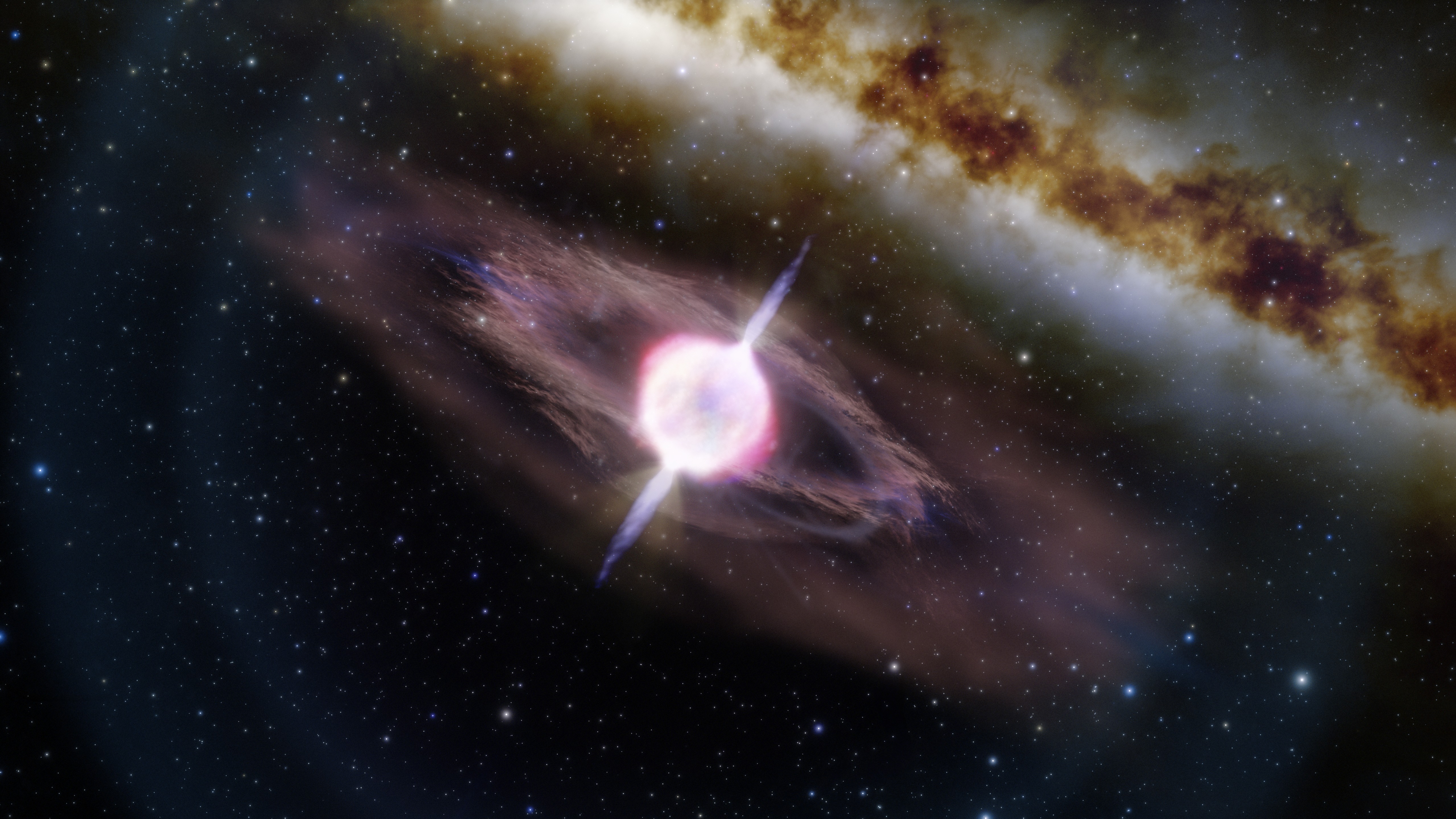On 9 October 2022 a flash of high-intensity gamma rays was detected by NASA’s Swift satellite coming from a galaxy 1.9 billion light-years away. Dubbed the ‘BOAT’ — the ‘brightest of all time’ — GRB 221009A was so exceptionally powerful that it actually sent shockwaves through Earth’s ionosphere, the outer layer of our planet’s atmosphere.
“If it had happened much closer, it would have been really bad,” says Brendan O’Connor, an astronomer from George Washington University.
A ‘long’ GRB (meaning that the burst of gamma rays can last several minutes) of this kind is typically the result of the death of a massive star, between 8 and 30 times the mass of our Sun. As it runs out of fuel in its core, the star contracts and then collapses to form either a neutron star or a black hole. In the process, the outer layers of the star cave in around it, forming a swirling disk of gas that powerful magnetic fields then sweep up and beam away in two fierce jets moving at close to the speed of light. The charged particles spiraling around the magnetic fields in these jets release gamma rays.
While most GRBs of this type take place much farther away, GRB 221009A’s relative proximity has given astronomers an unprecedented look into its central engine. In fact, the combination of intense brightness and closeness is so rare that astronomers don’t expect to see another GRB like it for another 1000 years on average.
“We knew that we would likely never get this opportunity again,” says Gokul Srinivasaragavan, a PhD student at the University of Maryland.
Using the Gemini South telescope, one half of the International Gemini Observatory operated by NSF’s NOIRLab, authors on two papers about this discovery, O’Connor and Srinivasaragavan, observed the explosion associated with GRB 221009A. One paper examines the ‘opening angle’ of the GRB jet, which can provide information about the process that emits the gamma rays, while the second paper described the search for the GRB’s optical counterpart — a supernova.
Typically, the jets of gamma rays from a GRB are fairly narrow, which means that comparatively few are pointed towards us. This limits how many GRBs we can detect; if they’re not pointed roughly towards us we cannot detect them.
This narrow opening angle is the result of the tightly wound magnetic fields that constrain the particle jet. However, GRB 221009A was different. Using Gemini South’s Multi-Object Spectrograph (GMOS) instrument, O’Connor’s team determined that GRB 221009A’s jet displayed a shape that has not been seen in the jets of other gamma-ray bursts.
The jet displayed a narrow core surrounded by wide, sloping wings. These features are not generally observed, which is puzzling, because if these wing-shaped jets happened often, astronomers would expect to have detected more of them by now. Instead, these broad wings must be very rare, just as rare as GRB 221009A is bright.
“There has to be something in these wide jets that is unique to ultra-powerful GRBs,” says O’Connor. “This particular shape of jet may be the signature of the most violent explosions, and explains why we kept seeing its optical and infrared glow for months after the explosion.”
Speaking of the optical glow, Srinivasaragavan led the search for the accompanying supernova — the visible light from the stellar explosion. Using Gemini South, as well as the GROWTH-India Telescope, the Lowell Discovery Telescope in Arizona and the Liverpool Telescope in Tenerife, Spain, Srinivasaragavan’s group was able to find evidence for the supernova, which is now known as SN 2022xiw.
The supernova SN 2022xiw turned out to be surprisingly underwhelming and not unlike other supernovae.
“We found that GRB 221009A’s associated core-collapse supernova is no more energetic or brighter than the others associated with long gamma-ray bursts previously studied,” says Srinivasaragavan. “This goes against our naïve expectations that a more powerful long gamma-ray burst will lead to a more powerful core-collapse supernova.”
From the brightness of the supernova Srinivasaragavan and O’Connor calculated that between 3.5 and 11.1 solar masses of material was ejected by the stellar blast. That’s up to 11 Suns-worth of material blown away in just seconds, and more energy liberated in that time than the Sun will produce in its entire lifetime.
The detail with which astronomers were able to observe GRB 221009A will pave the way for a greater understanding of the mechanism that produces a long GRB when a massive star ends its life. It may also become a ‘Rosetta stone’ of sorts for future ultra-luminous GRBs observed at greater distances.
Until then, GRB 221009A’s rarity means that it will last long in the memory, says Srinivasaragavan. “It was one of the most exciting events in recent memory for the astrophysical community as a whole.”
